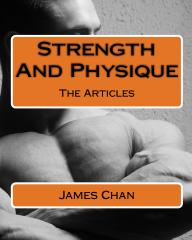The Inverse Relationship Between Volume and Frequency
Q: After reading all of your books and your theories on weight training, I was just wondering what your training theory was on training each muscle directly or indirectly 3 - 4 times a week. How do you achieve this or is it still necessary if you are an intermediate or advanced lifter?
I ask because I am an intermediate lifter and feel I need more volume to achieve results. How would I structure a program with higher volume to get the required frequency? Or is training each muscle twice a week with higher volume OK?
As always, many thanks and appreciation.
-Aaron
My Answer: There's an inverse relationship between frequency and volume. The higher the volume, the lower your frequency. The higher your frequency, the lower your volume.
Ectomorphs, beginners and older lifters will do better training frequently with lower volume. If you're trying to get stronger on a lift, then low volume/high frequency is a way to get stronger faster. So if you wanted to get stronger on dips, then you would do 1-2 sets of dips before every workout.
This is not to say you can't get stronger with high volume/low frequency. While the Russian and Eastern European strength athletes use high frequency to get stronger, American strength athletes tend to follow a high volume/low frequency approach. And guess what? You can still get very strong on low frequency.
As a general rule, low frequency works better for those who are already big and strong. So if you are an intermediate to advanced lifter, then you should already have some size and strength. When you're a newbie, you were probably pushing 8-12 reps and making some good gains.
But over time as you got stronger and more advanced, your reps have gravitated towards the lower range (4-8). Hitting this lower rep range activates the high threshold fast-twitch glycolytic muscle fibers (2B), which require more recovery time than the fast-twitch oxidative fibers (2A) that are activated when you are training in the 8-12 rep range.
The very fact that you are an intermediate lifter means you can train at a lower frequency. If you train in the lower rep range, then you need to make up for lower volume of low reps with a higher number of sets. Lower reps mean more sets. More sets means high volume. High volume necessitates lower frequency.
So to answer your question: yes, intermediate to advanced lifters can benefit from high volume/low frequency training. This is the reason why Training for the Busy Bodybuilder is meant for advanced trainees. So twice a week is fine.
This is not to say that advanced trainees can't train with high frequency. But for advanced trainees to train at high frequency they have to vary the volume from workout to workout. In fact, very advanced trainees will need to vary their volume from workout to workout just to keep getting bigger and avoid plateaus. The Neo-Classical Bodybuilding program shows high frequency/variable volume, which works better than static high volume/low frequency at building size, strength and a ripped physique.
Get Big and order the Strength and Physique E-books

“This book is terrific. It distills years of experience and research into short sections laying out specific, creative programs for the major body parts, using the best science and advanced training techniques. Some of them created by the great 'masters' of bodybuilding like Larry Scott. Almost every section has a 'eureka' idea that I'm craving to try, like the back trifecta! The book is much more useful than subscriptions to all the muscle mags. I only wish I had it when I was a kid."
- Bob Vastine, world record holder in powerlifting
"Your arm blast routine from Volume One that you pointed me to is phenomenal. Maybe it's just the pump, but I'm measuring 16 inches compared to 15 inches before - after just 2 trainings!"
- Steve Murphy, Australia
"Sticking to your principles to the letter has helped me improve immensely. When I started lifting over two years ago I was 125 pounds and now I'm over 170.
"What I'm trying to say is that reading your books helped me understand what I needed to do to gain [muscle]. My dedication plus your expertise really worked out well for me."
- Mike Crothers

I ask because I am an intermediate lifter and feel I need more volume to achieve results. How would I structure a program with higher volume to get the required frequency? Or is training each muscle twice a week with higher volume OK?
As always, many thanks and appreciation.
-Aaron
My Answer: There's an inverse relationship between frequency and volume. The higher the volume, the lower your frequency. The higher your frequency, the lower your volume.
Ectomorphs, beginners and older lifters will do better training frequently with lower volume. If you're trying to get stronger on a lift, then low volume/high frequency is a way to get stronger faster. So if you wanted to get stronger on dips, then you would do 1-2 sets of dips before every workout.
This is not to say you can't get stronger with high volume/low frequency. While the Russian and Eastern European strength athletes use high frequency to get stronger, American strength athletes tend to follow a high volume/low frequency approach. And guess what? You can still get very strong on low frequency.
As a general rule, low frequency works better for those who are already big and strong. So if you are an intermediate to advanced lifter, then you should already have some size and strength. When you're a newbie, you were probably pushing 8-12 reps and making some good gains.
But over time as you got stronger and more advanced, your reps have gravitated towards the lower range (4-8). Hitting this lower rep range activates the high threshold fast-twitch glycolytic muscle fibers (2B), which require more recovery time than the fast-twitch oxidative fibers (2A) that are activated when you are training in the 8-12 rep range.
The very fact that you are an intermediate lifter means you can train at a lower frequency. If you train in the lower rep range, then you need to make up for lower volume of low reps with a higher number of sets. Lower reps mean more sets. More sets means high volume. High volume necessitates lower frequency.
So to answer your question: yes, intermediate to advanced lifters can benefit from high volume/low frequency training. This is the reason why Training for the Busy Bodybuilder is meant for advanced trainees. So twice a week is fine.
This is not to say that advanced trainees can't train with high frequency. But for advanced trainees to train at high frequency they have to vary the volume from workout to workout. In fact, very advanced trainees will need to vary their volume from workout to workout just to keep getting bigger and avoid plateaus. The Neo-Classical Bodybuilding program shows high frequency/variable volume, which works better than static high volume/low frequency at building size, strength and a ripped physique.
Get Big and order the Strength and Physique E-books

“This book is terrific. It distills years of experience and research into short sections laying out specific, creative programs for the major body parts, using the best science and advanced training techniques. Some of them created by the great 'masters' of bodybuilding like Larry Scott. Almost every section has a 'eureka' idea that I'm craving to try, like the back trifecta! The book is much more useful than subscriptions to all the muscle mags. I only wish I had it when I was a kid."
- Bob Vastine, world record holder in powerlifting
"Your arm blast routine from Volume One that you pointed me to is phenomenal. Maybe it's just the pump, but I'm measuring 16 inches compared to 15 inches before - after just 2 trainings!"
- Steve Murphy, Australia
"Sticking to your principles to the letter has helped me improve immensely. When I started lifting over two years ago I was 125 pounds and now I'm over 170.
"What I'm trying to say is that reading your books helped me understand what I needed to do to gain [muscle]. My dedication plus your expertise really worked out well for me."
- Mike Crothers



Comments